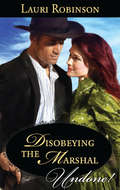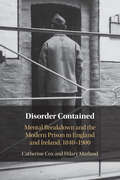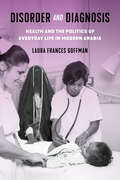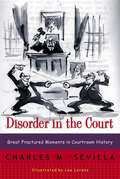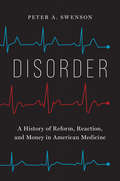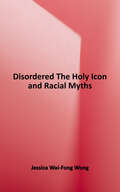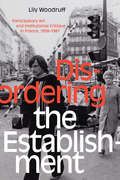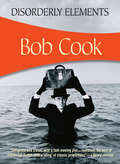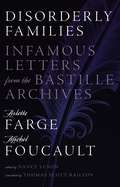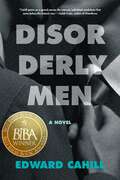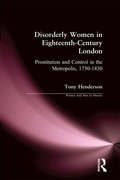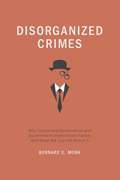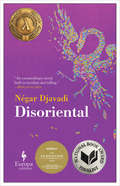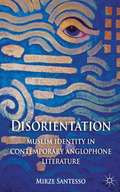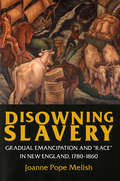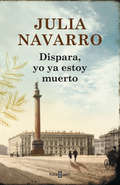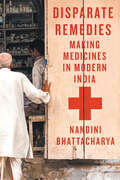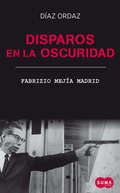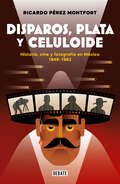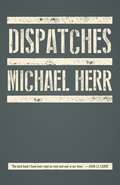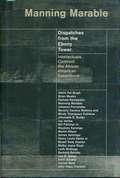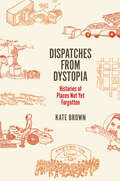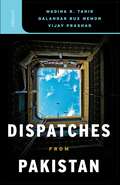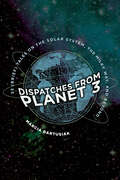- Table View
- List View
Disobeying the Marshal
by Lauri RobinsonEl Dorado, Kansas, 1881Marshal Cord Donovan believed he was married to his badge-until one incredible night in Florie Rockford's bed changed everything. When Florie unexpectedly arrives in town with a desperate warning for his safety, Cord is determined to show her that their spark burns so hot that one night will never be enough.But Florie has returned with more than just a warning-the consequence of their passion defies all the lawman's rules!
Disorder Contained: Mental Breakdown and the Modern Prison in England and Ireland, 1840 – 1900
by Catherine Cox Hilary MarlandDisorder Contained is the first historical account of the complex relationship between prison discipline and mental breakdown in England and Ireland. Between 1840 and 1900 the expansion of the modern prison system coincided with increased rates of mental disorder among prisoners, exacerbated by the introduction of regimes of isolation, deprivation and hard labour. Drawing on a range of archival and printed sources, the authors explore the links between different prison regimes and mental distress, examining the challenges faced by prison medical officers dealing with mental disorder within a system that stressed discipline and punishment and prisoners' own experiences of mental illness. The book investigates medical officers' approaches to the identification, definition, management and categorisation of mental disorder in prisons, and varied, often gendered, responses to mental breakdown among inmates. The authors also reflect on the persistence of systems of punishment that often aggravate rather than alleviate mental illness in the criminal justice system up to the current day. This title is also available as Open Access.
Disorder and Diagnosis: Health and the Politics of Everyday Life in Modern Arabia
by Laura Frances GoffmanDisorder and Diagnosis offers a social and political history of medicine, disease, and public health in the Persian Gulf from the late nineteenth century until the 1973 oil boom. Foregrounding the everyday practices of Gulf residents—hospital patients, quarantined passengers, women migrant nurses, and others too often excluded from histories of this region—Laura Frances Goffman demonstrates how the Gulf and its Arabian hinterland served as a buffer zone between "diseased" India and white Europe, as a space of scientific translation, and, ultimately, as an object of development. In placing health at the center of political and social change, this book weaves the Gulf and Arabian Peninsula into global circulations of commodities and movements of people. As a collection of institutions and infrastructures, pursuits of health created shifting boundaries of rule between imperial officials, indigenous elites, and local populations. As a set of practices seeking to manipulate the natural world, health policies compelled scientists and administrators to categorize fluid populations and ambiguous territorialities. And, as a discourse, health facilitated notions of racial difference, opposing native uncleanliness to white purity and hygiene, and indigenous medicine to modern science. Disorder and Diagnosis examines how Gulf residents, through their engagements with health, fiercely contested and actively shaped state and societal interactions.
Disorder in the Court: Great Fractured Moments in Courtroom History
by Charles M. SevillaFrom the book: PRO PER MOTION (E. Grossman, Berkeley) THE COURT DO you understand, sir, that if I permit you to represent yourself, it will be without the assistance of an attorney and that you're going to be held to all the technical rules of evidence in criminal procedure? DEFENDANT Yeah. I'll have to stop at the library and get a book on law. THE COURT And you understand you will get access to the jail library? DEFENDANT Yeah. THE COURT DO you understand that the case as presented by the State will be handled by an experienced district attorney who's very specialized in the area of criminal law, who has had extensive court trials and jury trials, and that you won't be entitled to any special consideration? DEFENDANT All I really need is the Constitution, the Bill of Rights, a Holy Bible and a handgun. Uses of Language (Keith Arthur, Stockton, CA) THE COURT You were picked up on a new 245? DEFENDANT I don't know if it was 245, 645, 345. They picked me up on something, all right? Okay? Then when they also had me on that, he gave me a motherfucking charge for prostitution. COUNSEL Don't use language like that to the judge. DEFENDANT Prostitution? What? Prostitution? What you want me to say? They picked me up for prostitution.
Disorder: A History of Reform, Reaction, and Money in American Medicine
by Peter A. SwensonAn incisive look into the problematic relationships among medicine, politics, and business in America and their effects on the nation&’s health &“A comprehensive, revealing and surprising account of the history of American medicine.&”—David Blumenthal, M.D., coauthor of The Heart of Power: Health and Politics in the Oval Office and president of the Commonwealth Fund &“This book is both an important contribution to the history of the American medical profession (and its impact on society as a whole), and a reminder of the malleable, historically contingent nature of its identity and ethos.&”—Scott H. Podolsky, M.D., author of The Antibiotic Era Meticulously tracing the dramatic conflicts both inside organized medicine and between the medical profession and the larger society over quality, equality, and economy in health care, Peter A. Swenson illuminates the history of American medical politics from the late nineteenth century to the present. This book chronicles the role of medical reformers in the progressive movement around the beginning of the twentieth century and the American Medical Association&’s dramatic turn to conservatism later. Addressing topics such as public health, medical education, pharmaceutical regulation, and health-care access, Swenson paints a disturbing picture of the entanglements of medicine, politics, and profit seeking that explain why the United States remains the only economically advanced democracy without universal health care. Swenson does, however, see a potentially brighter future as a vanguard of physicians push once again for progressive reforms and the adoption of inclusive, effective, and affordable practices.
Disordered: The Holy Icon and Racial Myths
by Jessica Wai-Fong WongArchetypes of race loom large within the Western imagination. The Black population, in particular, has often been pictured as inherently disordered, and their presence thought to have a disordering effect--indeed, their presence has been seen as a threat to civilized society. It is this perceived threat of blackness that has fueled America's long history of discrimination and oppression. At the heart of this racialized way of seeing is a significant theological assertion: that one's internal state can be discerned through the external attributes of the body. In the Byzantine era, the holy icon was thought to reflect the proper order of God; those who rejected the icon rejected God's order. The supposedly deficient bodies of those who rejected the holy order of God functioned as a warning sign. <p><p>Using the framework of icon theology, Disordered explores the relationship between non-white, as well as non-masculine, bodies and civilized society at key moments in the development of modernity. Jessica Wai-Fong Wong demonstrates how the archetype of (male) whiteness has come to define proper social order. The veneration of the white man as holy ideal wields significant power over the formation of subjects and the shaping of society. In this case, worship of whiteness in general, and white masculinity in particular, functions as the sacred ground upon which the oppressive structures of Western society are built. <p><p>The iconic reading of race offered here not only creates an opportunity for analysis but also opens up a space for constructive Christological intervention that confronts the troubled practices at the heart of racialized sight. Jesus invites all people into a different way of seeing, one that shatters the distorting and destructive assumptions embedded within the dominant racial logic. By learning to see Jesus, the true icon of God, we learn to see rightly. And, when we see rightly, the order defining our identity and relationality is redeemed.
Disordering the Establishment: Participatory Art and Institutional Critique in France, 1958–1981 (Art History Publication Initiative)
by Lily WoodruffIn the decades following World War II, France experienced both a period of affluence and a wave of political, artistic, and philosophical discontent that culminated in the countrywide protests of 1968. In Disordering the Establishment Lily Woodruff examines the development of artistic strategies of political resistance in France in this era. Drawing on interviews with artists, curators, and cultural figures of the time, Woodruff analyzes the formal and rhetorical methods that artists used to counter establishment ideology, appeal to direct political engagement, and grapple with French intellectuals' modeling of society. Artists and collectives such as Daniel Buren, André Cadere, the Groupe de Recherche d’Art Visuel, and the Collectif d’Art Sociologique shared an opposition to institutional hegemony by adapting their works to unconventional spaces and audiences, asserting artistic autonomy from art institutions, and embracing interdisciplinarity. In showing how these artists used art to question what art should be and where it should be seen, Woodruff demonstrates how artists challenged and redefined the art establishment and their historical moment.
Disorderly Elements
by Bob CookA humorous debut spy novel for fans of Ross Thomas, featuring a Cold War MI6 intelligence analyst who uses rumors of a leak to defer his imminent layoff.“There’s a recession on, you know.” With an unemployed son and a baby on the way, these are not words that Michael Wyman wants to hear, particularly not from his employers, the university where he’s a professor of philosophy, or the British secret service for which he’s worked for 30 years. And he most particularly doesn’t want to hear them from both employers at once, accompanied by the information that he’s being laid off without a pension.Happily, a miracle is at hand, in the form of a Communist spy burrowed deep in the highest reaches of British intelligence. An East German defector can identify the spy, thus safeguarding national security and protecting the government from crippling embarrassment. He is willing to give up the information, but only to one man. At fifty-six years old, Wyman has one last chance to get back in the game . . . and get out on his own terms.Praise for Disorderly Elements“A delightful and clever first novel with a fast-moving plot, extremely witty dialogue, and a style that combines the best of espionage fiction with a “sting” of classic proportions.” —Library Journal“The writing is unusually alert, and it is hard to believe that Disorderly Elements is a first novel. Mr. Cook's 56-year-old Michael Wyman is one of the more unusual heroes in espionage fiction.” —The New York Times“Witty, irreverent, and tremendously amusing.” —Liverpool Echo (UK)“Spy fiction has a splendid new recruit.” —The Observer (UK)
Disorderly Families: Infamous Letters from the Bastille Archives
by Michel Foucault Arlette FargeThe first English translation of letters of arrest from eighteenth century France held in the archives of the Bastille Drunken and debauched husbands; libertine wives; vagabonding children. These and many more are the subjects of requests for confinement written to the king of France in the eighteenth century. These letters of arrest (lettres de cachet) from France&’s Ancien Régime were often associated with excessive royal power and seen as a way for the king to imprison political opponents. In Disorderly Families, first published in French in 1982, Arlette Farge and Michel Foucault collect ninety-four letters from ordinary families who, with the help of hired scribes, submitted complaints to the king to intervene and resolve their family disputes. Gathered together, these letters show something other than the exercise of arbitrary royal power, and offer unusual insight into the infamies of daily life. From these letters come stories of divorce and marital conflict, sexual waywardness, reckless extravagance, and abandonment. The letters evoke a fluid social space in which life in the home and on the street was regulated by the rhythms of relations between husbands and wives, or parents and children. Most impressively, these letters outline how ordinary people seized the mechanisms of power to address the king and make demands in the name of an emerging civil order. Arlette Farge and Michel Foucault were fascinated by the letters&’ explosive qualities and by how they both illustrated and intervened in the workings of power and governmentality. Disorderly Families sheds light on Foucault&’s conception of political agency and his commitment to theorizing how ordinary lives come to be touched by power. This first English translation is complete with an introduction from the book&’s editor, Nancy Luxon, as well as notes that contextualize the original 1982 publication and eighteenth-century policing practices.
Disorderly Men
by Edward CahillWINNER, IPPY BOOK AWARDS, LGBTQ+ FICTIONWINNER, 2023 BEST INDIE BOOK AWARD, LGBTQ2 FICTIONSHORT LIST, VCU CABELL FIRST NOVELIST AWARDON LAMBDA LITERARY REVIEW'S SEPTEMBER MOST ANTICIPATED LISTONE OF QUEER FORTY'S BEST PRIDE READS FOR SUMMER 2023!Three gay men in pre-Stonewall New York City find their fates thrown together in the police raid of a Village bar.Roger Moorhouse is a Wall Street banker and Westchester family man with a preciously guarded secret. As the shouting begins and flashlights blaze in his face, the life he’s carefully curated over the years—a fancy new office overlooking lower Broadway, a house in Beechmont Woods, his wife and children—is about to come crashing down around him.Columbia literature professor Julian Prince lives a comparatively uncloseted life when he finds his first committed relationship tested to its limits. How could he explain to Gus, a fearless young artist, that he couldn’t stay with him that weekend because the woman who was still technically Julian’s fiancée would be visiting? But when Gus is struck unconscious by a police baton, Julian comes out of hiding to protect him, even if exposure means losing everything.For Danny Duffy, an Irish kid from the Bronx with a sassy mouth and a diverse group of friends, the raid is a galvanizing, Spartacus moment. Danny doesn’t have too much left to lose; his family has just disowned him. But once his name appears in the newspaper, he’ll be fired from his job at Sloan’s Supermarket, where he’s risen to assistant manager of produce, and begin a journey that veers between political enlightenment and violent revenge.The three men find themselves in a police wagon together, their hidden lives threatened to be revealed to the world. Blackmail, a private investigator, Gus’s disappearance, and Danny’s quest for retribution propel Disorderly Men to its piercing conclusion, as each man meets the boundaries of his own fear, love, and shame. The stakes for each are different, but all of them confront a fundamental question: How much happiness is he allowed to have . . . and what share of it will he lay claim to?
Disorderly Women in Eighteenth-Century London: Prostitution and Control in the Metropolis, 1730-1830 (Women And Men In History)
by Tony HendersonThis is the first full-length study of prostitution in London during the eighteenth and early nineteenth centuries. It is a compelling account, exposing the real lives of the capital's prostitutes, and also shedding light on London society as a whole, its policing systems and its attitudes towards the female urban poor. Drawing on the archives of London's parishes, jury records, reports from Southwark gaol as well as other sources which have been overlooked by historians, it provides a fascinating study for all those interested in Georgian society.
Disorganized Crimes
by Bernard E. MunkCorporate misgovernance and the failure of government regulation have led to major financial fiascos. 'Disorganized crimes' are disruptive and costly. Munk links the two major eras of corporate misgovernance during the last decade to explain how these events occur and what can be done to prevent them from re-occurring.
Disoriental
by Négar DjavadiNational Book Award Finalist: &“A multigenerational epic of the Sadr family&’s life in Iran and their eventual exile . . . Full of surprises&” (The Globe and Mail).Winner of the 2019 Albertine Prize and Lambda Literary Award Kimiâ Sadr fled Iran at the age of ten in the company of her mother and sisters to join her father in France. Now twenty-five and facing the future she has built for herself, as well as the prospect of a new generation, Kimiâ is inundated by her own memories and the stories of her ancestors, which come to her in unstoppable, uncontainable waves. In the waiting room of a Parisian fertility clinic, generations of flamboyant Sadrs return to her, including her formidable great-grandfather Montazemolmolk, with his harem of fifty-two wives, and her parents, Darius and Sara, stalwart opponents of each regime that befalls them. It is Kimiâ herself—punk-rock aficionado, storyteller extraordinaire, a Scheherazade of our time, and above all a modern woman divided between family traditions and her own &“disorientalization&”—who forms the heart of this bestselling and beloved novel, recipient of numerous literary honors. &“Where initially Disoriental seems focused on Kimiâ&’s father and his pro-democracy activism—first against the Shah, then the Ayatollah Khomeini—this is truly Kimiâ&’s story of disorientation—national, familial and sexual—and finding herself again.&” —The Globe and Mail &“A tour de force of storytelling . . . Djavadi deftly weaves together the history of 20th-century Iran [and] the spellbinding chronicle of her own ancestors. . . . Perfectly blends historical fact with contemporary themes.&” —Library Journal &“Riveting . . . Djavadi is an immensely gifted storyteller, and Kimiâ&’s tale is especially compelling.&” —Booklist (starred review) &“A wonder and a pleasure to read.&” —Rivka Galchen, author of Atmospheric Disturbances WINNER 2019 ALBERTINE PRIZE WINNER 2019 LAMBDA LITERARY AWARD FINALIST 2018 NATIONAL BOOK AWARD FINALIST 2019 CLMP FIRECRACKER AWARD FINALIST 2019 BEST TRANSLATED BOOK AWARD WINNER LE PRIX DU ROMAN NEWS WINNER STYLE PRIZE WINNER 2016 LIRE BEST DEBUT NOVEL WINNER LA PORTE DORÉE PRIZE ONE OF THE GLOBE & MAIL&’S BEST BOOKS OF 2018
Disorientation: Muslim Identity in Contemporary Anglophone Literature
by Esra Mirze SantessoFocusing on British novels about the Muslim immigrant experience published after 9/11; this book examines the promise as well as the limits of 'British Muslim' identity as a viable form of self-representation, and the challenges - particularly for women - of reconciling non-Western religious identity with the secular policies of Western states.
Disowning Slavery: Gradual Emancipation and "Race" in New England, 1780–1860
by Joanne Pope MelishFollowing the abolition of slavery in New England, white citizens seemed to forget that it had ever existed there. Drawing on a wide array of primary sources--from slaveowners' diaries to children's daybooks to racist broadsides--Joanne Pope Melish reveals not only how northern society changed but how its perceptions changed as well. Melish explores the origins of racial thinking and practices to show how ill-prepared the region was to accept a population of free people of color in its midst. Because emancipation was gradual, whites transferred prejudices shaped by slavery to their relations with free people of color, and their attitudes were buttressed by abolitionist rhetoric which seemed to promise riddance of slaves as much as slavery. Melish tells how whites came to blame the impoverished condition of people of color on their innate inferiority, how racialization became an important component of New England ante-bellum nationalism, and how former slaves actively participated in this discourse by emphasizing their African identity. Placing race at the center of New England history, she contends that slavery was important not only as a labor system but also as an institutionalized set of relations. The collective amnesia about local slavery's existence became a significant component of New England regional identity.
Dispara, yo ya estoy muerto (Edición exclusiva)
by Julia NavarroEsta edición contiene en exclusiva el relato La Rusia de Dispara, yo ya estoy muerto, un fascinante viaje a través de la historia, la literatura y la gastronomía de la Rusia imperial retratada en Dispara, yo ya estoy muerto. Un recorrido por una época histórica convulsa y un escenario único, desde la Rusia de finales del siglo XIX hasta la etapa soviética y comunista. Dispara, yo ya estoy muerto es una historia llena de historias, una gran novela que esconde muchas novelas y que, desde su enigmático título hasta su inesperado final, alberga más de una sorpresa y emociones a flor de piel. Hay momentos en la vida en los que la única manera de salvarse a uno mismo es muriendo o matando. A finales del siglo XIX, durante la última etapa zarista, los Zucker, perseguidos por su condición de judíos, tienen que abandonar Rusia huyendo del horror y la sinrazón. A su llegada a la Tierra Prometida, Samuel Zucker adquiere las tierras de los Ziad, una familia árabe encabezada por Ahmed. Entre él y Samuel nace un fuerte vínculo, una sólida amistad que, por encima de las diferencias religiosas y políticas, se mantiene generación tras generación. Con las amenazas, la sed de venganza y muchas pasiones desatadas como telón de fondo, las vidas entrecruzadas de los Zucker y los Ziad conforman un mosaico de traiciones y sufrimientos, de amores posibles e imposibles, al tiempo que plasman la gran aventura de vivir y convivir en un territorio marcado por la intolerancia. Intensa y conmovedora crónica de dos sagas familiares, esta novela de Julia Navarro nos adentra en las vidas de personas con nombres y apellidos, que luchan por alcanzar sus sueños y que son responsables de su propio destino. «Los personajes de esta novela viven conmigo, me han enseñado mucho, forman parte ya de mi historia personal.»Julia Navarro La crítica ha dicho...«La novela más compleja de Julia Navarro. Casi mil páginas que mezclan historia y suspense, drama y política. Una obra decimonónica en pleno siglo XXI.»J. M. Pozuelo Yvancos, ABC Cultural «Una novela de personajes, unas criaturas en gran medida presas de su época y de los vaivenes históricos de ésta. Un relato ambicioso que se inicia a finales del siglo XIX y llega hasta 1948 recorriendo algunos de los sucesos más importantes de la historia contemporánea.»AreaLibros «Una intensa y emocionada crónica de una saga familiar que ahonda en el vértigo de la condición humana al tiempo que propone una conmovedora reivindicación de que por encima de las patrias están las personas.»La Región
Disparate Remedies: Making Medicines in Modern India (Intoxicating Histories #7)
by Nandini BhattacharyaAt present India is a leading producer, distributor, and consumer of generic medicines globally. Disparate Remedies traces the genealogy of this development and examines the public cultures of medicine in the country between 1870 and 1960.The book begins by discussing the expansion of medical consumerism in late nineteenth-century India when British-owned firms extended their sales into remote towns. As a result, laboratory-produced drugs competed with traditional remedies through side-by-side production of Western and Indian drugs by pharmaceutical companies. The emergent middle classes, the creation of a public sphere, and nationalist politics transformed the medical culture of modern India and generated conflict between Western and Indigenous medical systems and their practitioners. Nandini Bhattacharya demonstrates that these disparate therapies were sustained through the tropes of purity or adulteration, potency or lack of it, and epistemic heritage, even when their material configuration often differed little.Uniquely engaging with the cultures of both consumption and production in the country, Disparate Remedies follows the evolution of medicine in colonial India as it confronted Indian modernity and changing public attitudes surrounding health and drugs.
Disparos en la oscuridad
by Fabrizio Mejía MadridFabrizio Mejía Madrid ofrece el retrato del presidente más odiado de México: Gustavo Díaz Ordaz. Del autor de Arde la calle, Fabrizio Mejía Madrid. Un retrato de Díaz Ordaz donde no sólo lo vemos a él, sino a otros presidentes de esa República del PRI, de gobernadores, presidentes municipales, jueces, diputados, senadores y, por qué no, de alguien a quien todos, al menos en parte, llevamos dentro. Un Primer Mandatario no tiene derecho a la infelicidad. Para eso están los gobernados, escribió Carlos Monsiváis como un resumen a setenta años de presidencialismo mexicano, sufrido desde la sociedad. Este libro trata justo de lo contrario: la infelicidad de los que nos gobiernan. A través de una investigación exhaustiva de la figura del presidente Díaz Ordaz, acaso el más odiado y temido de la historia nacional de México, Fabrizio Mejía Madrid traza no sólo la biografía de este personaje, sino también la del tipo de arreglos, ideas, y taras de la forma de hacer política que lo hicieron posible. Trata del primer Presidente que actuó creyendo que la matanza era la única cara necesaria del poder y que murió exiliado de un país, de un mundo, que nunca logró comprender.
Disparos, plata y celuloide: Historia, cine y fotografía en México 1846-1982
by Ricardo Pérez MontfortEn cierto sentido, la historia no es lo que ocurrió, sino lo que creemos que ocurrió. Piense usted en Pancho Villa. La imagen que tiene en la mente fue fijada por una fotografía o una película. Y sucede exactamente igual con Lázaro Cárdenas, Emiliano Zapata, una adelita, «un tendero gallego de los años cincuenta», «un apacible pueblito de provincia», cualquier «rancho de inicios del siglo XX» y, de hecho, con buena parte de los grandes momentos, referencias y personajes de la historia mexicana.En este sentido, el cine y la fotografía nos han “enseñado” más historia que los libros de la SEP. En esta obra, el historiador Ricardo Pérez Montfort ofrece una serie de ensayos sobre este fenómeno. ¿Cómo es que la memoria colectiva ha sido delineada por el celuloide? ¿Qué mitos de la historia patria son culpa de los haluros de plata? ¿Cuáles son algunas de las representaciones másdelirantes de los próceres mexicanos? ¿Qué significa que nuestra educación histórica se haya forjado en salas oscuras? ¿Quién da forma a la memoria de un país? Con una prosa rigurosa y entrañable, el autor inicia su recorrido a finales del siglo XIX, transita por el Porfiriato, “observa a los observadores” de la Revolución, atestigua la conformación identitaria del México moderno, mira cómo el cine ha construidohéroes y demonios, y termina con un drama cuya importancia no hemos terminado de aquilatar: el incendio de la Cineteca Nacional en 1982.
Dispatches (Vintage International #23)
by Michael Herr"He seems to have brought to this book the ear of a musician and the eye of a painter ... the premier war correspondence of Vietnam."--Washington Post. "The best book I have ever read on men and war in our time."--John le Carre. "... Dispatches puts the rest of us in the shade."--Hunter S. Thompson.
Dispatches From the Ebony Tower: Intellectuals Confront the African American Experience
by Manning MarableWhat constitutes black studies and where does this discipline stand at the end of the twentieth century? In this wide-ranging and original volume, Manning Marable -- one of the leading scholars of African American history -- gathers key materials from contemporary thinkers who interrogate the richly diverse content and multiple meanings of the collective experiences of black folk. Here are numerous voices expressing very different political, cultural, and historical views, from black conservatives, to black separatists, to blacks who advocate radical democratic transformation. Here are topics ranging from race and revolution in Cuba, to the crack epidemic in Harlem, to Afrocentrism and its critics. All of these voices, however, are engaged in some aspect of what Marable sees as the essential triad of the black intellectual tradition: describing the reality of black life and experiences, critiquing racism and stereotypes, or proposing positive steps for the empowerment of black people. Highlights from Dispatches from the Ebony Tower: #149; Henry Louis Gates Jr. and Manning Marable debate the role of activism in black studies. #149; John Hope Franklin reflects on his role as chair of the President's race initiative. #149; Cornel West discusses topics that range from the future of the NAACP through the controversies surrounding Louis Farrakhan and black nationalism to the very question of what "race" means. #149; Amiri Baraka lays out strategies for a radical new curriculum in our schools and universities. #149; Marable's introduction provides a thorough overview of the history and current state of black studies in America.
Dispatches from Dystopia: Histories of Places Not Yet Forgotten
by Kate BrownWhy are Kazakhstan and Montana the same place? asks one chapter of Kate Brown s surprising and unusual journey into the histories of places on the margins, overlooked or erased. It turns out that a ruined mining town in Kazakhstan and Butte, Montana America s largest environmental Superfund site have much more in common than one would think thanks to similarities in climate, hucksterism, and the perseverance of their few hardy inhabitants. Taking readers to these and other unlikely locales, "Dispatches from Dystopia" delves into the very human and sometimes very fraught ways we come to understand a particular place, its people, and its history. In "Dispatches from Dystopia, " Brown wanders the Chernobyl Zone of Alienation, first on the Internet and then in person, to figure out which version the real or the virtual is the actual forgery. She also takes us to the basement of a hotel in Seattle to examine the personal possessions left in storage by Japanese-Americans on their way to internment camps in 1942. In Uman, Ukraine, we hide with Brown in a tree in order to witness the annual male-only Rosh Hashanah celebration of Hasidic Jews. In the Russian southern Urals, she speaks with the citizens of the small city of Kyshtym, where invisible radioactive pollutants have mysteriously blighted lives. Finally, Brown returns home to Elgin, Illinois, in the midwestern industrial rust belt to investigate the rise of rustalgia andthe waysher formative experiences have inspired her obsession with modernist wastelands. "Dispatches from Dystopia" powerfully and movingly narrates the histories of locales that have been silenced, broken, or contaminated. In telling these previously unknown stories, Brown examines the making and unmaking of place, and the lives of the people who remain in the fragile landscapes that are left behind. "
Dispatches from Pakistan
by Madiha R. TahirSince 9/11, Pakistan has loomed large in the geopolitical imagination of the West. A key ally in the global war on terror, it is also the country in which Osama bin Laden was finally found and killed—and the one that has borne the brunt of much of the ongoing conflict&’s collateral damage. Despite its prominence on the front lines and on the front pages, Pakistan has been depicted by Western observers simplistically in terms of its corruption, its fundamentalist Islamic beliefs, and its propensity for violence. Dispatches from Pakistan, in contrast, reveals the complexities, the challenges, and the joys of daily life in the country, from the poetry of Gilgit to the graffiti of Gwadar, from an army barrack in Punjab to the urban politics of Karachi.This timely book brings together journalists, activists, academics, and artists to provide a rich, in-depth, and intriguing portrait of contemporary Pakistani society. Straddling a variety of boundaries—geographic, linguistic, and narrative—Dispatches from Pakistan is a vital attempt to speak for the multitude of Pakistanis who, in the face of seemingly unimaginable hardships, from drone strikes to crushing poverty, remain defiantly optimistic about their future. While engaging in conversations on issues that make the headlines in the West, the contributors also introduce less familiar dimensions of Pakistani life, highlighting the voices of urban poets, rural laborers, industrial workers, and religious-feminist activists—and recovering Pakistani society&’s inquilabi (revolutionary) undercurrents and its hopeful overtones.Contributors: Mahvish Ahmad; Nosheen Ali, U of California, Berkeley; Shafqat Hussain, Trinity College; Humeira Iqtidar, King&’s College London; Amina Jamal, Ryerson U; Hafeez Jamali, U of Texas at Austin; Iqbak Khattak; Zahra Malkani; Raza Mir; Hammad Nasar; Junaid Rana, U of Illinois at Urbana–Champaign; Maliha Safri, Drew U; Aasim Sajjad Akhtar, Lahore U of Management Sciences; Ayesha Siddiqa; Sultan-i-Rome, Government Jahanzeb Postgraduate College, Swat, Pakistan; Saadia Toor, Staten Island College.
Dispatches from Planet 3: 32 (Brief) Tales on the Solar System, the Milky Way, and Beyond
by Marcia BartusiakAn award-winning science writer presents a captivating collection of cosmological essays for the armchair astronomerThe galaxy, the multiverse, and the history of astronomy are explored in this engaging compilation of cosmological tales by multiple-award-winning science writer Marcia Bartusiak. In thirty-two concise and engrossing essays, the author provides a deeper understanding of the nature of the universe and those who strive to uncover its mysteries.Bartusiak shares the back stories for many momentous astronomical discoveries, including the contributions of such pioneers as Beatrice Tinsley, with her groundbreaking research in galactic evolution, and Jocelyn Bell Burnell, the scientist who first discovered radio pulsars. An endlessly fascinating collection that you can dip into in any order, these pieces will transport you to ancient Mars, when water flowed freely across its surface; to the collision of two black holes, a cosmological event that released fifty times more energy than was radiating from every star in the universe; and to the beginning of time itself.
